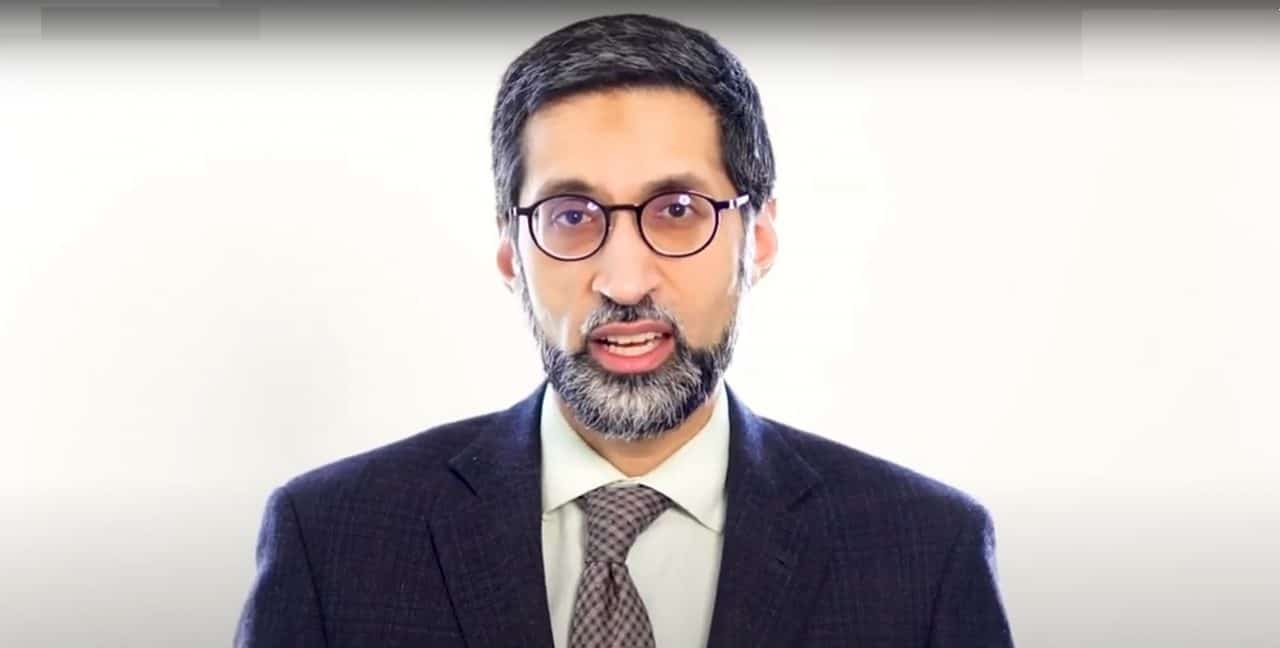‘Far more COVID-19 going around’; Niagara’s Dr. Hirji responds after Ontario’s top doc admits there may 20,000 cases daily
Published March 3, 2022 at 9:30 pm

Niagara Region’s acting medical officer of health, Dr. Mustafa Hirji, is offering a reminder that the COVID-19 pandemic is not over.
Ontario Chief Medical Officer of Health Dr. Kieran Moore said Thursday (March 3) that mask mandates in Ontario will be removed by March 31 if positive public health trends continue. However, Moore acknowledged that the province may have more than 20,000 new COVID-19 cases per day, which would be a ten-fold increase than the official case count.
Dr. Hirji highlighted that in a social media post.
“FAR more #COVID19 going around now than at peaks of any previous waves,” he wrote.
“Getting vaccinated, wearing masks, and avoiding crowded places remains absolutely key. The onus is on us now to keep ourselves & those around us safe with the province dropping most protections.”
Yup. FAR more #COVID19 going around now than at peaks of any previous waves.
Getting vaccinated, wearing masks, and avoiding crowded places remains absolutely key. The onus is on us now to keep ourselves & those around us safe with the province dropping most protections. https://t.co/r1bSnwemie
— Mustafa Hirji (@mustafahirji) March 4, 2022
Moore acknowledged that the underreporting of COVID-19 cases is due to limited access to PCR testing. The true number of daily new COVID-19 cases can be estimated by multiplying the number of positive tests by 10 – meaning there may be more than 22,000 new Ontario cases Thursday, instead of the 2,262 that were reported.
Niagara Region reported 93 new cases, which means it could have 930 new cases. Neighbouring Hamilton and Haldimand-Norfolk combined had fewer new cases than Niagara, with 66 and 19 respectively.
Moore said he will monitor the effects of Ontario’s reopening, which saw capacity limits lift and the vaccine certificate system end on Tuesday, but if all goes well mandatory masking policies could soon be gone.
“I do believe they are protective, they do decrease your personal risk,” Moore said.
“But as the chief medical officer of health, we can only mandate masking for so long. As long as the risk is decreasing, we’ll make a decision together as a province to remove them.”
Change management is difficult in a pandemic, Moore said.
“The removal of masks, I’m sure, will make some feel ill at ease, but also will allow others the freedom to not wear – who may have already had COVID and/or have had their second doses, third doses, and feel confident that they will not require hospitalization if they get ill,” he said.
Prior to Moore’s media availability, Hirji also re-tweeted a link to an article at medicalxpress.com about a new theoretical model researchers have developed to better assess the risks of spreading viruses such as COVID-19, both with and without a mask.
“The results show that a surgical face mask and, to an even greater extent, an FFP2 mask provide excellent protection that significantly reduces the risk of infection,” says the article, which summarizes research from scientists at universities in Austria, Italy and Sweden. “Provided that the face mask is worn correctly, the risk of infection is negligible even at distances as short as one meter, regardless of environmental conditions and if the person is talking, coughing or sneezing.”
FFP stands for “filtering face piece,” which is the European standard. In North America, the top respirator masks are known as KN95s and N95s.
Face #masks play a crucial role, new #COVID research confirms https://t.co/2vrNWxKfQW cc @carlyweeks @adamsmiller
From study: "…wearing face masks provides excellent protection, effectively limiting the transmission of pathogens even at short physical distances…"
— Timothy Caulfield (@CaulfieldTim) March 3, 2022
Ontario is tracking the Omicron subvariant B.A.2 in the province. It is 30 per cent more transmissible than B.A.1, which was the culprit for the fifth wave of the pandemic. While B.A.2 is well on the way to becoming the dominant strain in Ontario, Moore is confident there will not be another full-blown wave.
“(The) combination of natural immunity plus vaccine immunity is building a strong wall of defence for Ontario against B.A.2 and potentially a recurrence of Delta,” he said.
The University of Toronto epidemiologist Dr. David Fisman, a former member of the Ontario Science Table, also stated on Thursday that he does not see a surge happening. But he also said caution should remain the order of the day.
“This isn’t a reason to abandon caution, but it’s hard to see a BA2 surge happening in Ontario right now,” he said. “There are lots of moving parts and it may yet, but I don’t see any evidence in support of that right now.”
As previous, and this isn't a reason to abandon caution, but it's hard to see a BA2 surge happening in Ontario right now. There are lots of moving parts and it may yet, but I don't see any evidence in support of that right now.
— David Fisman (@DFisman) March 3, 2022
However, Fisman also got out in front of Moore’s press conference. On Thursday morning, he tweeted graphic from the U.S. based Centres for Disease Control (CDC) that illustrated that mask-wearing — which is not mandated in most areas of the United States — significantly lowered one’s odds of testing positive for COVID-19. Someone who always wore a cloth mask, per the CDC, was 56 per cent less likely to test positive. Surgical mask wearers were 66 per cent less likely, and KN95/N95 wearers were 83 per cent less likely.
An infected person, of course, can spread the virus to immunocompromised people and vaccine-ineligible children under age five. Recent British research has suggested the effects of COVID-19 on children is more significant than first believed.
A reminder ahead of todays very serious Ontario press conference: masks are the easiest, cheapest tools we have for further reducing disease transmission right now pic.twitter.com/PhlZHsTJyp
— David Fisman (@DFisman) March 3, 2022
In Niagara, 50.4 of the population has had at least three doses of COVID-19 vaccine. The full-vaccination uptake is at 83.9 per cent, and 87.3 per cent have had at least one dose.
In the youngest age group, children five to 11, only 25.5 per cent of children have had two doses, and 49 per cent have had a first dose.
Niagara and Hamilton have nearly identical uptake in the general population. But Hamilton is a bit ahead with the youngest age cohort, with 30.4 per cent of five- to 11-year-olds having had two doses while 51.8 have received at least one dose.
However, both areas’ first-dose uptake was behind the provincewide average, which was 54.1 per cent as of the last update at covid19tracker.ca four weeks ago on Feb. 5. At that time, the uptake for that age group was 12th of 13th provinces and territories in Canada, besting only Alberta.
— with files from The Canadian Press
INsauga's Editorial Standards and Policies








